USS Pampanito and SS Jeremiah O’Brien: WWII maritime history in San Francisco
After learning about how “Rosie the Riveter” constructed Liberty Ships in the Kaiser Shipyards in Richmond, across the bay from San Francisco, it seemed to me that the obvious next step was to tour an actual Liberty Ship. (See my post on the Rosie the Riveter Museum here.) I ended up seeing not only a Liberty Ship, the SS Jeremiah O’Brien, but also a World War II submarine, the USS Pampanito.
The SS Jeremiah O’Brien
The SS Jeremiah O’Brien was built in Maine, not Richmond, but all 18 shipyards around the country that produced Liberty Ships followed the same design. It served in the war carrying supplies for troops around the world, including Normandy during the D-Day invasion.
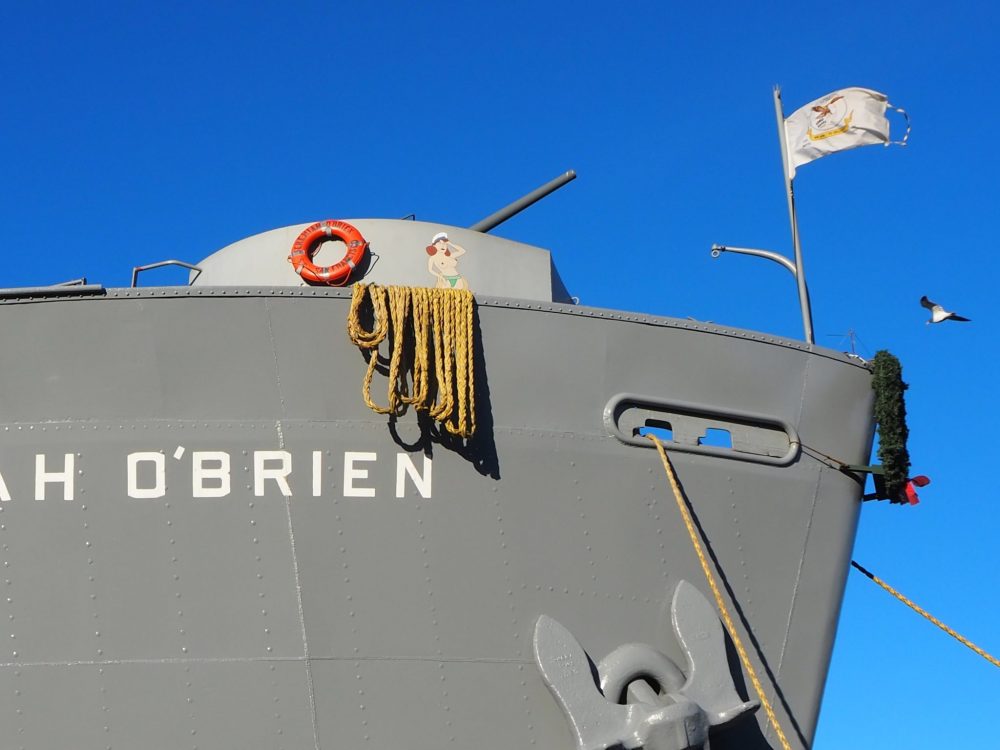
What’s special about the Jeremiah O’Brien is that it is in its original state. In full working order, a team of volunteers restored it, staffs it, maintains it, and takes it out on cruises around San Francisco Bay.
In total, 2710 Liberty Ships were built during the war. Originally meant as cargo transports, some were later converted for troop transport and, after the Allied victory in North Africa, for transport of prisoners of war.
More than 2400 Liberty ships outlasted the war to be bought for use as cargo ships by private companies. Today, only three remain, two of which are museum ships.
(Victory Ships, by the way, had a similar design, but were a bit larger and faster. The SS Red Oak Victory, docked in Richmond, is one of these.)
Touring the SS Jeremiah O’Brien
After I paid admission, a volunteer handed me a flyer with a simple map of the ship and pointed me up the gangway. Happy to be able to explore the ship at my own pace, I took my time. On an off-season weekday afternoon, I had the ship almost to myself.
It was easy to imagine what it was like to sail on this ship. Visitors may not enter many of the rooms, but I could look into all of them. The beds were made up neatly in the crew’s quarters – and sometimes not so neatly. I could see belongings on beds, chairs, or hung on the walls. It looked as if the crew had only just left. Judging from the kinds of items I saw – modern backpacks, for example, and laminated i.d. cards on lanyards, I’m pretty sure the volunteers who maintain and operate the ship still use the crew’s quarters. Other rooms looked they might have during the war. The kitchen and mess area are still in use, it was clear, presumably by the volunteers.
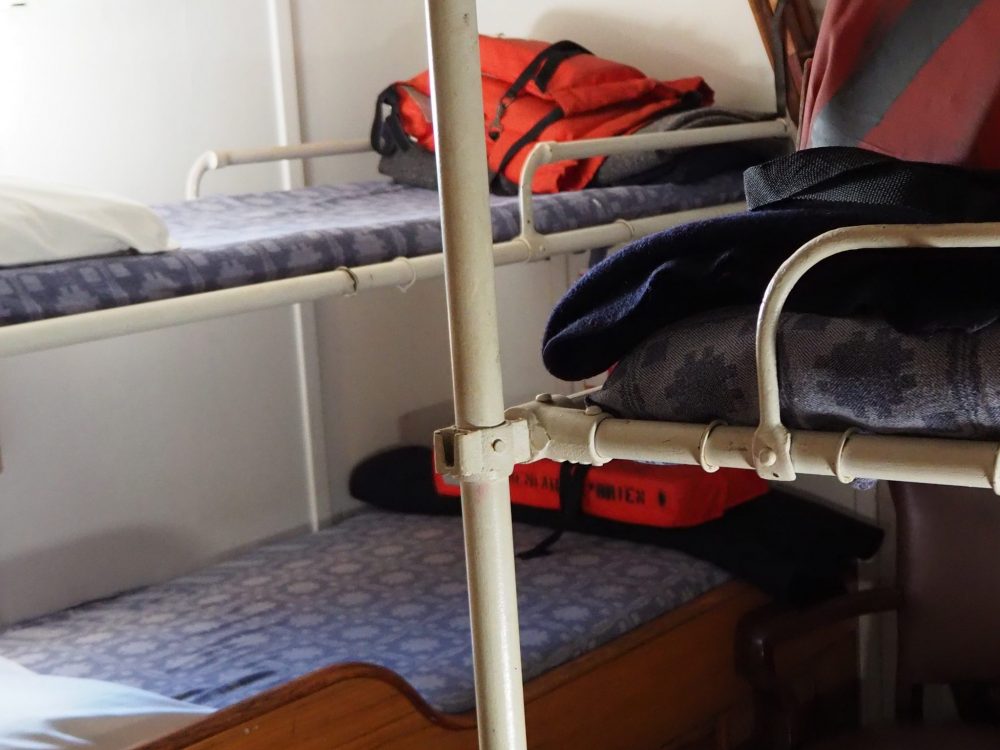
The ship originally carried 41 civilian merchant mariners and 18 navy gunners, who traveled with the ship to defend it in case of attack. I imagine that voyages entailed long periods of dull routine – cleaning and maintenance – interspersed with short periods of tension and fear, as they entered areas with active conflict.
Besides the main deck with the crew’s living quarters, visitors can climb the stairs and ladders up or down. On the boat deck upstairs, I could see offices and living quarters of the officers. Further up, on the bridge deck, are the Captain’s quarters and the chart room – now with GPS navigation. This deck is also home to the radio room – still in working order – and the bridge.
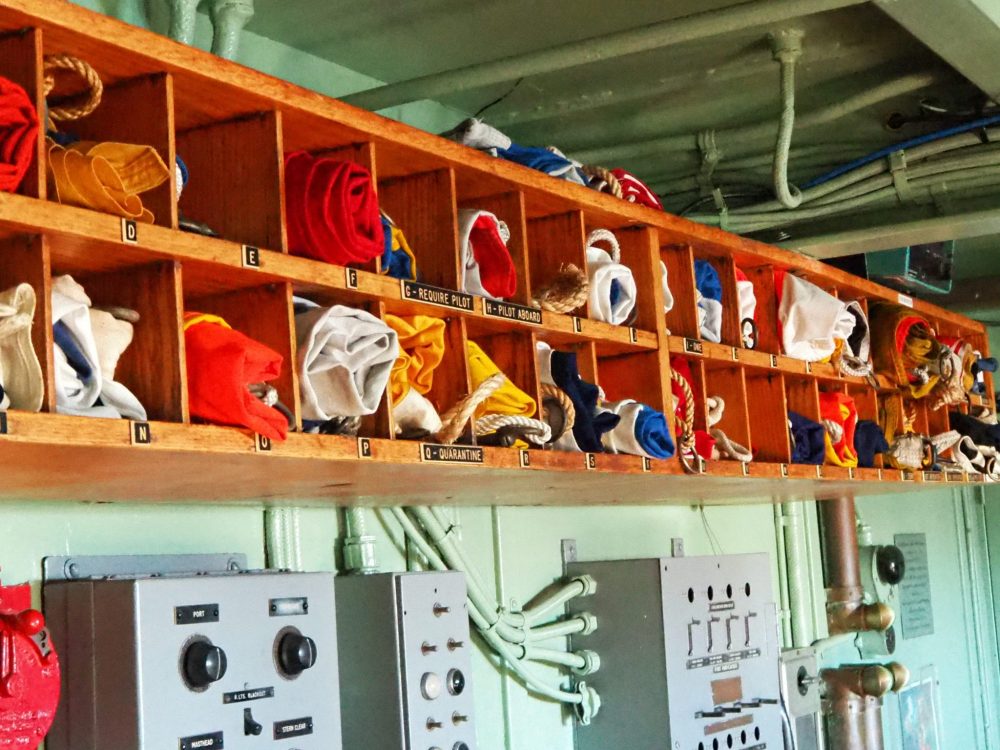
Downstairs from the main deck is the engine room, a maze of machinery that was completely incomprehensible to me. A sign explains how this 3-cyclinder triple expansion engine works.
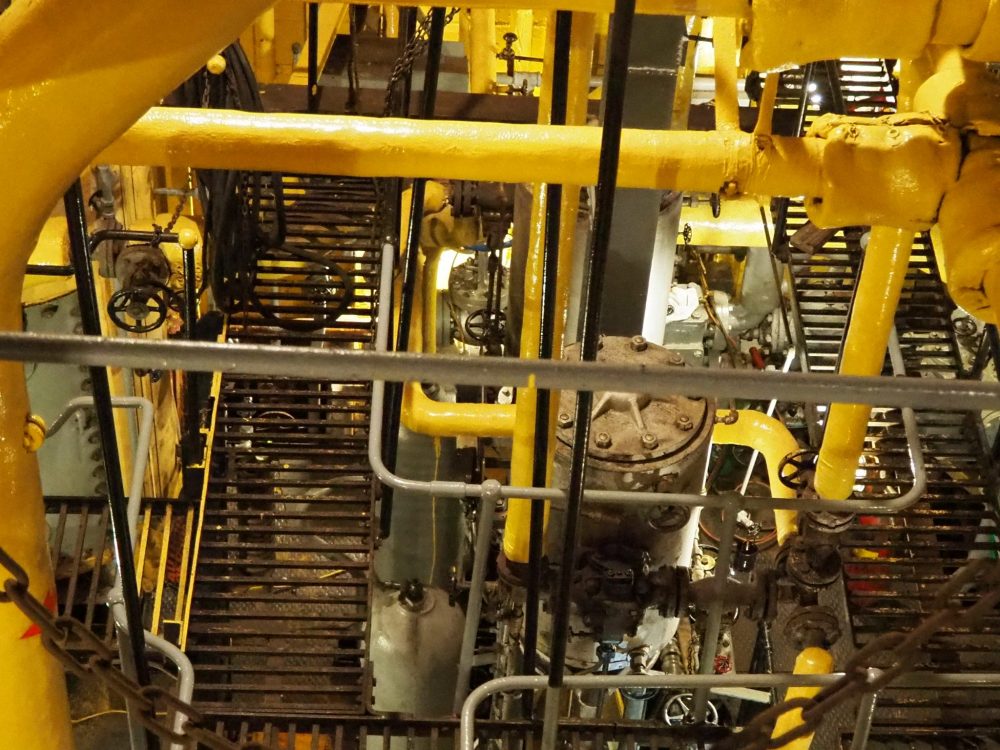
Also below are the cargo spaces: a section of one of the spaces provides room for a small museum and event space. If you visit, make sure to peer down through the glass-covered hole. Looking down will give you a sense of the size of the cargo hold. Liberty Ships could carry 10,000 metric tons of cargo.
On deck
Outdoors, on the deck of the SS Jeremiah O’Brien, I could investigate the lives of the accompanying navy gunners. Their guns sat up high, making them easy targets. For that reason, the machine guns are surrounded by concrete walls meant to protect the gunner.
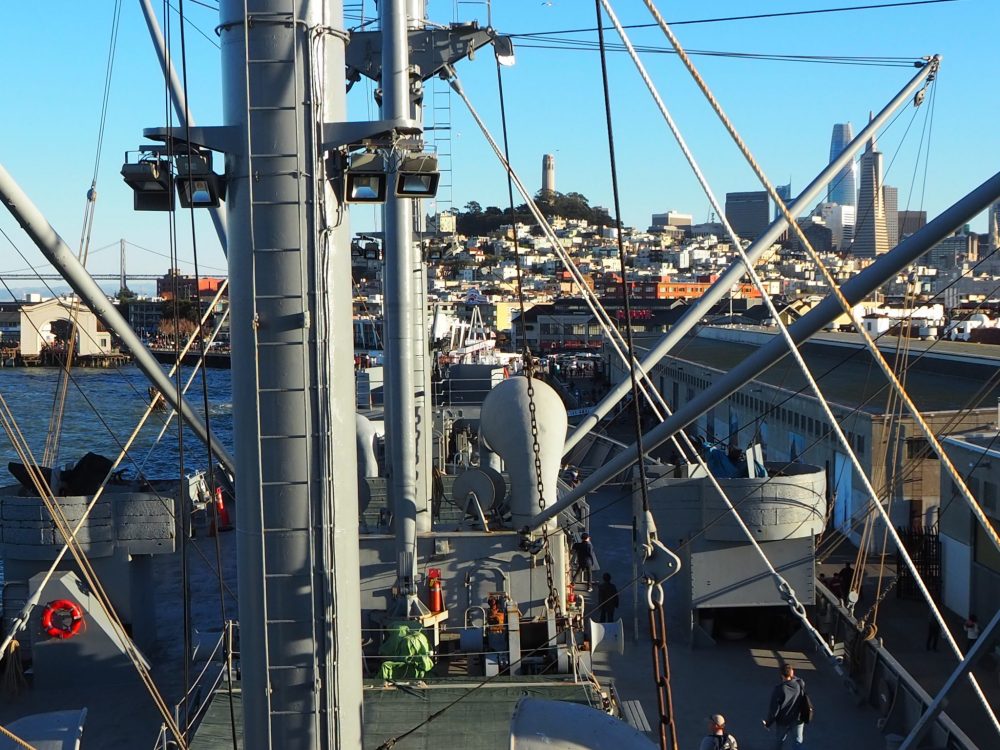
The SS Jeremiah O’Brien is moored at Pier 45, the next major pier to the tourist mecca at Pier 39, which I wrote about on my last trip to San Francisco. From its decks I had some great views. Looking toward the city, I could see Telegraph Hill with Coit Tower at its peak, and, beyond that, the city center with its skyscrapers. On San Francisco Bay, modern cargo ships passed, laden with piles of shipping containers. Looking toward the Bay, I could see the new sections of the Bay Bridge, a suspension bridge. Looking the other way, toward the ocean, I could see the elegant curve of the Golden Gate Bridge.
USS Pampanito
While I expected to visit a Liberty Ship, I was pleased to see, moored in front of the SS Jeremiah O’Brien, a World War II submarine, the USS Pampanito.
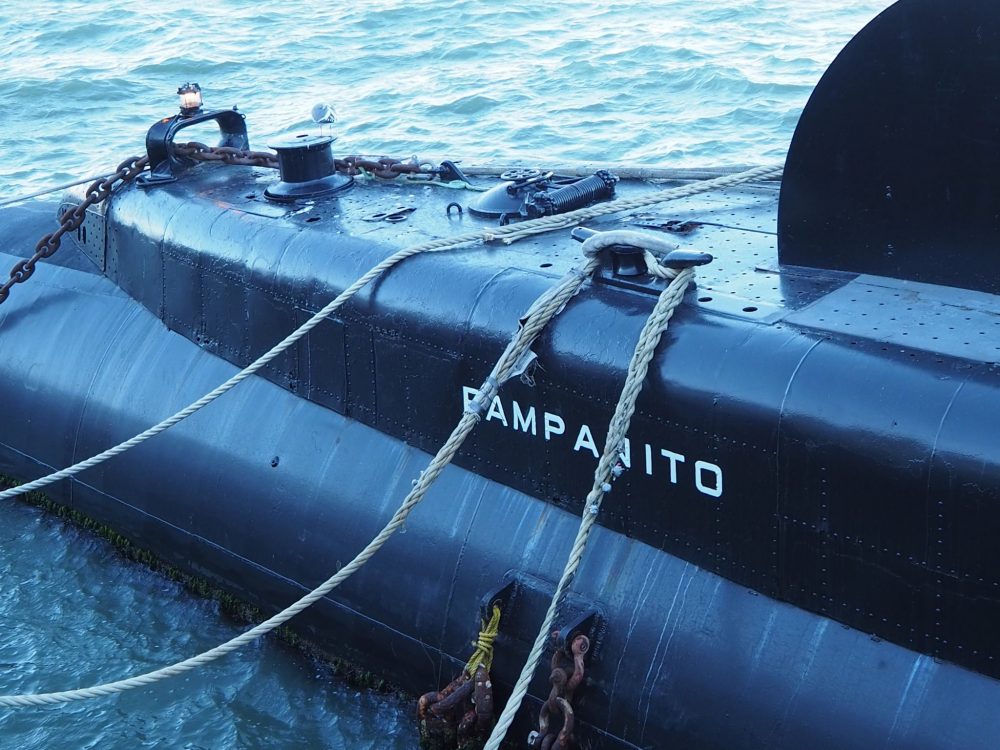
In this case, after paying admission, I received a set of headphones and an ipod. In each section of the submarine, an audio recording played automatically. Telling the history of the ship, including testimony of men who served on it, the recording distinctly added to my understanding of what I was seeing.
On the day I visited in December, San Francisco was experiencing strong winds, enough for my phone to send me regular wind advisory messages. While I did not feel any effect of this on the SS Jeremiah O’Brien, I certainly felt it inside the much smaller USS Pampanito. It rocked noticeably in the rough water. The movement added to the sense of claustrophobia that must have been part of everyday life on board a submarine.
Read my other posts about World War II-related sights: World War II and Cold War sites in Berlin, The Dutch Resistance Museum, Ruminations on an Auschwitz tour, or A day trip to Hiroshima.
The USS Pampanito’s history
This particular submarine, built in 1943, carried out six patrols in the Pacific in a little more than a year. It sank six Japanese ships and damaged four more. On one of its patrols, it picked up 79 Australian and British POWs who had been floating on rafts for days after the Japanese ship transporting them sank. Saving them, the submarine’s crew almost doubled in population for the five days it took to get to the nearest Allied port.
Visiting this ship is not for the claustrophobic, and not for anyone with physical limitations. Except for one added hatch, the submarine is unchanged, so moving from one “room” to the next involves stepping up and over a raised threshold through an oval porthole. It’s best to climb the stairways backwards, like a ladder.
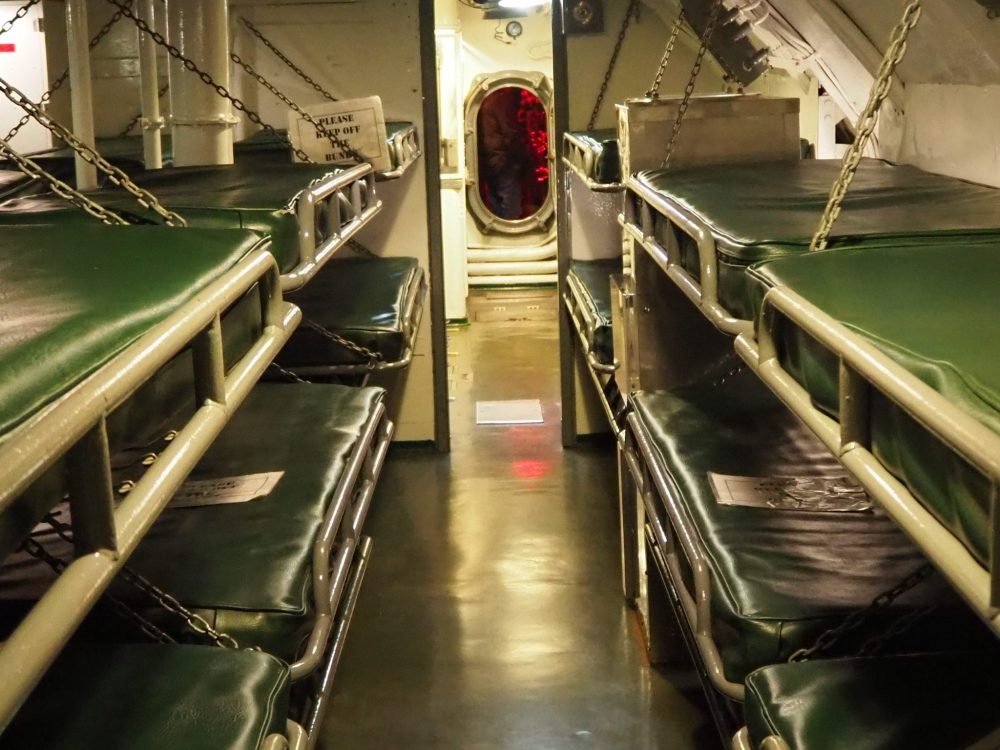
Restored to its 1945 state, the USS Pampanito shows what life was like aboard a submarine during the war. As with my visit to the SS Jeremiah O’Brien, I could easily imagine the long periods of boredom broken by moments of frantic activity and fear: diving to avoid attack, playing cat and mouse with other ships. In both ships, the most evocative places for me were the living quarters: rather roomy on the Liberty Ship, densely packed on the submarine.
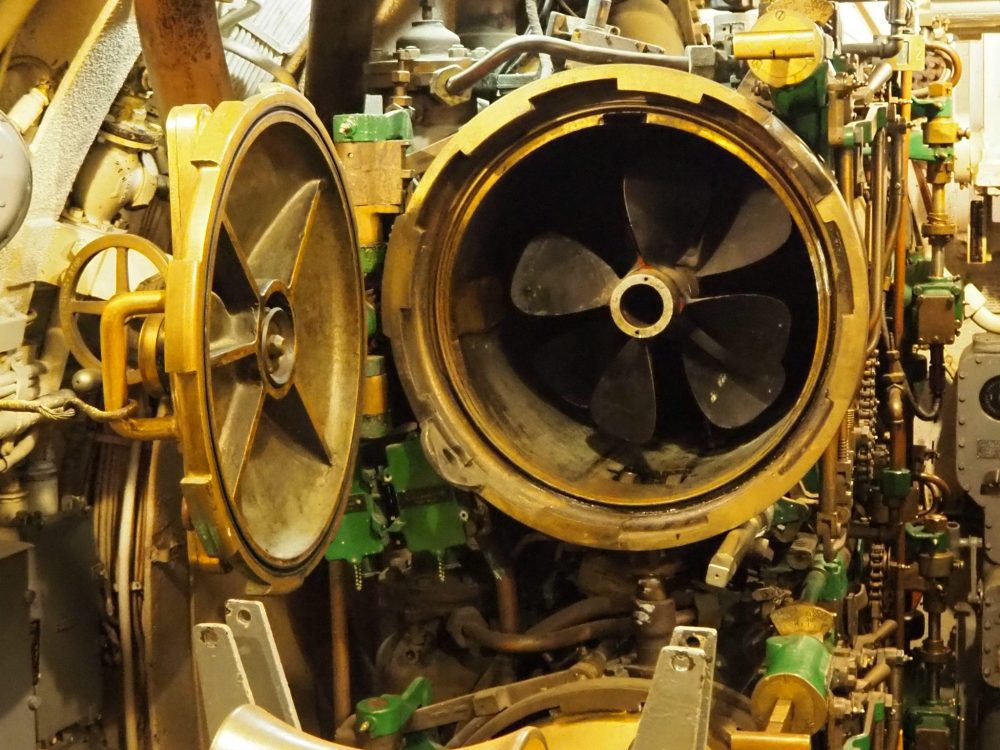
Visitors Information
If you like to see historic ships, make sure to walk down the shore toward the Golden Gate Bridge afterwards. The San Francisco Maritime National Historical Park has several older ships and a museum at the Hyde Street Pier.
SS Jeremiah O’Brien: Pier 45, corner of Taylor and Embarcadero, San Francisco. Open daily, 9:00-16:00. Admission $20.
USS Pampanito: Pier 45, Corner of Taylor and Embarcadero, San Francisco. Opens at 9:00 daily, varied closing hours. Admission $20.
San Francisco Maritime National Historical Park: Hyde Street Pier, 2905 Hyde Street. The pier is open daily 9:30-17:00, while the Maritime Museum, in the Aquatic Park Bathhouse Building, is open daily 10:00-16:00. Free to walk on the pier and view the ships from outside; free to visit the museum. $10 to board the ships.
I’d appreciate it if you would share this post on social media! The images below are formatted for Pinterest.


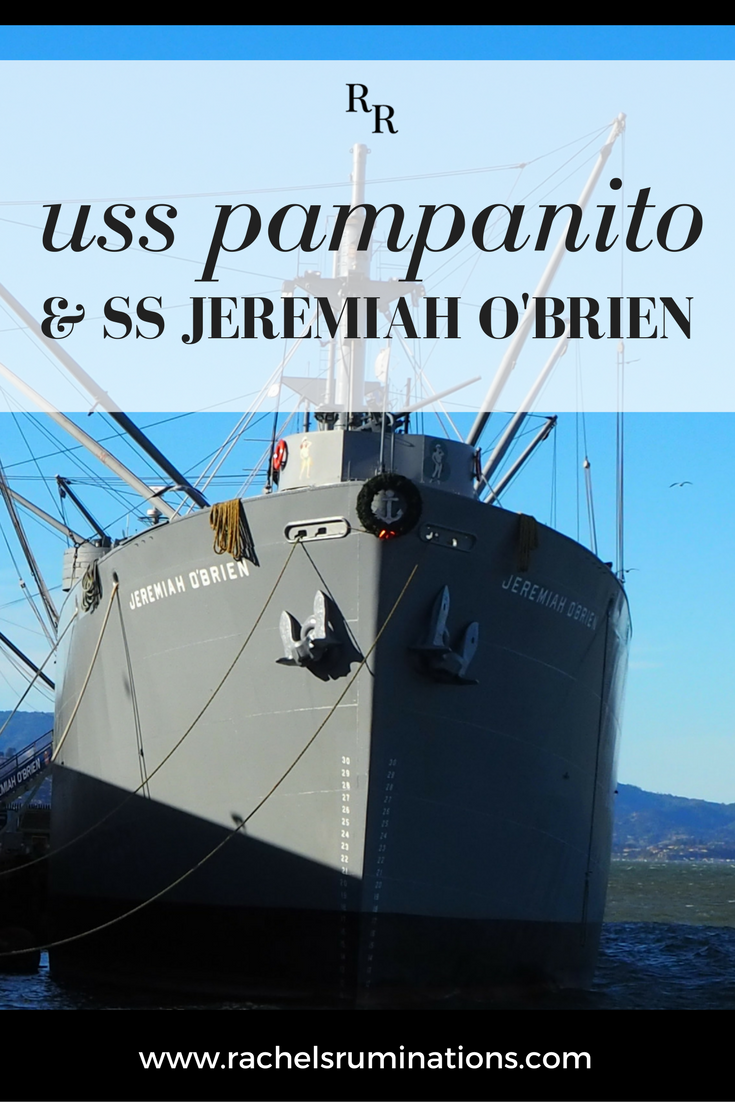
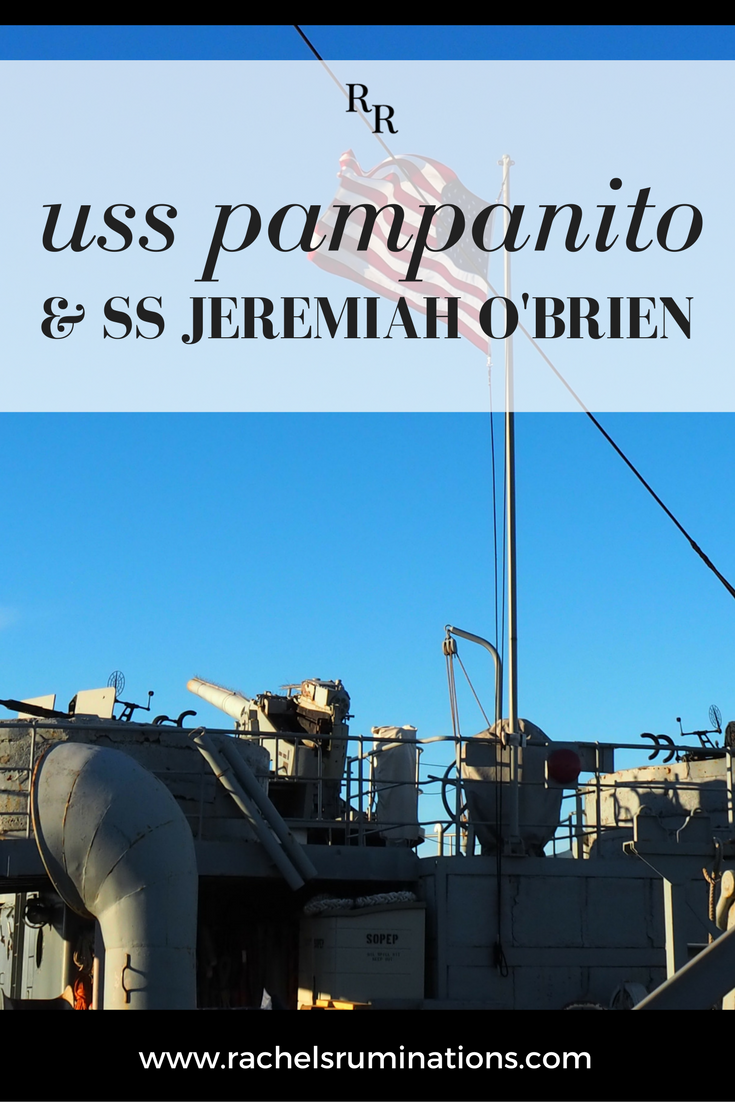
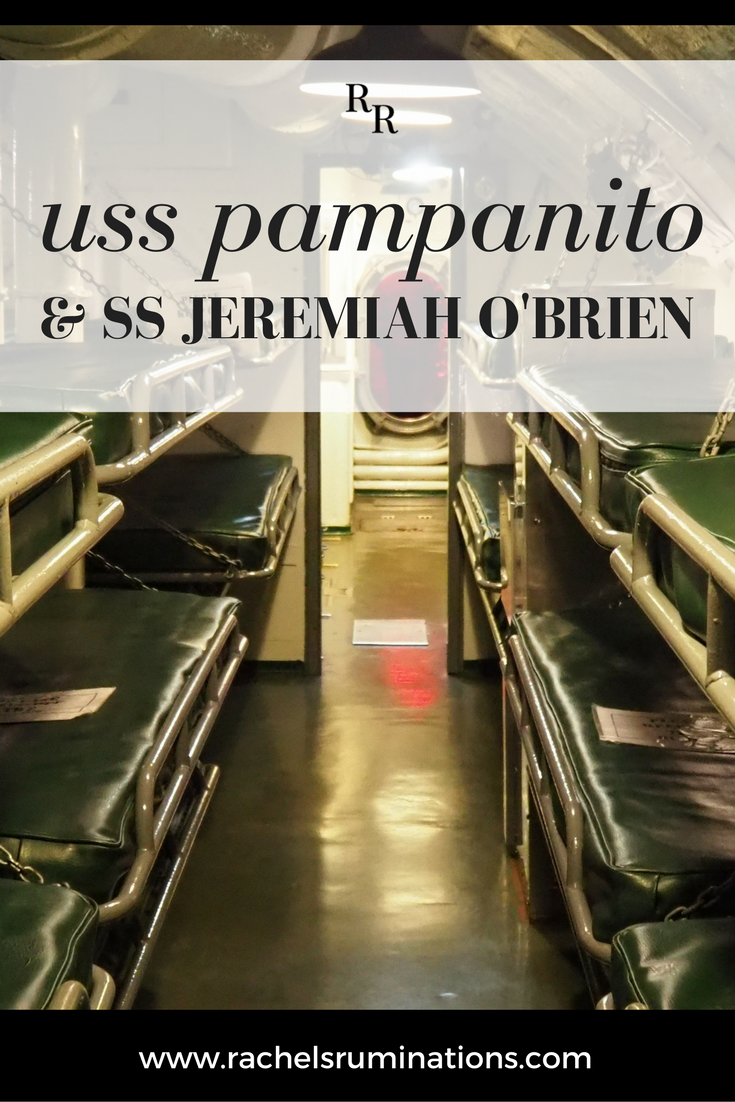

Touring these ships is such a reflection of what the men sacrificed and continue to sacrifice to protect our nation. I read with interest about USS Pampanito and SS Jeremiah O’Brien and also what went into building them.
It was risky to travel on a Liberty ship, even if they were just cargo ships. They were cranked out fast because they were expected to get sunk!
What grand ships these two are. We visited the USS New Jersey in Philly last year, and it looks to be similar to the USS Jeremiah Obrien. We haven’t been on a submarine, but the USS Pampanito looks like it would be interesting to visit. Thanks for sharing, and we love your photos.
Thanks for the compliment! I finally bit the bullet and bought a proper camera and I love it! The New Jersey is a battleship; can you wander all over it like you can the Jeremiah O’Brien and the Pampanito?
My wife and i did this tour a few years ago when visiting San Francisco! Well worth the visit,especially for history buffs. The submarine was quite the experience. Can’t imagine what those brave sailors endured living in those conditions underwater. Thanks for sharing the excellent photos and memories. 🙂
I know! It would have been a miserable place to be: frightening, crowded, no privacy, smelly. They were so brave!
It’s been quite a while since I’ve visited the Jeremiah O’Brien. I enjoyed getting reacquainted through your images.
I’ve never been on a submarine. That would be interesting. Halifax played a big part in both wars. Every service person went through Halifax, the there were German u-boats right outside of our harbour. Every convoy that left for Europe was protected by a fleet of boats. If you visit Halifax you can tour one of these vessels, the HMCS Sackville. It’s located on the waterfront. Thanks for co-hosting this week. #TPThursday
Is the Sackville a fighting vessel rather than cargo? Is it restored so that it’s operational?
Your post makes me realize how little I know about the Bay area. I have not heard about the ship or submarine. I think I have more reasons than before to pay a visit (I have only been once to San Francisco). I have been on submarines and agree it is not necessarily a pleasant feeling. I do not feel claustrophobic but I am not sure how I would feel after being inside one for weeks. #TPThursday
I’m not particularly claustrophobic, but I’d get very nervous about being in a submerged submarine. It just doesn’t seem safe!
My son enjoys learning about military history and whenever he and my husband travel together they seek out opportunities like this one. They aren’t big on cities so I’m sure they would choose visiting this ship and submarine rather than touring San Francisco! I’ll have to remember this the next time I’m in the Bay Area.
They’d like the Rosie the Riveter Museum as well, I bet! I wrote about it here: https://rachelsruminations.com/rosie-the-riveter-museum/. And they might like Fort Point too, just under the Golden Gate Bridge.
Anyone who goes in a submarine, especially these old ones is a hero in my book. I wouldn’t even like to go on a modern day hi-tech one. Inspecting a submarine would be wonderful for many people. I’d like to have a look see as long as it was firmly floating on the surface lol.
This one is on the surface and tied to a pier, so no worries!